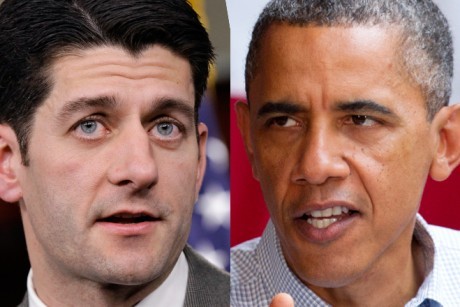President Barack Obama’s budget plan would continue policies that have made the economic recovery since 2009 the weakest since the Great Depression, whereas those of Rep. Paul Ryan (R-WI) would return the federal government to its modern average level of spending and growth, says Heartland Institute Senior Fellow Peter Ferrara.
Ryan had already made a name for himself with his budget proposal aimed at shrinking the growth of federal spending and the national debt before Republican Presidential challenger Mitt Romney picked him as his running mate. That budget proposal has provided ammunition for Democrats to use against Romney and for Republicans to use against Obama.
Ferrara conducted a study comparing the Ryan and Obama budget plans, published as a Heartland Institute Policy Brief, in which he writes, “President Obama’s budget establishes a future course that exacerbates the current fiscal problem,” whereas Ryan’s budget “fixes the problem so that it doesn’t eat alive the United States’ world-leading standard of living.”
Ferrara says, “I wrote the report to show the dramatic difference between the Ryan budget and the Obama budget, which I think should define this election. The Obama budget puts America on the expressway to Greece and national bankruptcy, with federal spending and the national debt exploding like the Big Bang.”
Return to Historical Average
Ferrara says the most important point in the Policy Brief “is that for all the yelling and screaming about Ryan’s budget, all it does is return federal spending to its long-term postwar historical average since World War II up until 2008, of 20 percent of GDP [gross domestic product], which it does by 2015, erasing Obama’s one-quarter increase in federal spending.
“The second-most important point is that Ryan’s budget gets the national debt under control, declining every year until it reaches just 10 percent of GDP in 2050—and that is under static scoring by the Congressional Budget Office.”
Ferrara argues Ryan’s Medicare proposal is better for senior citizens than Medicare under Obamacare, and that Ryan’s Medicaid proposal is better for the poor than Medicaid under Obamacare.
“Romney has stayed very close to Ryan throughout this campaign, and in picking him it cannot be said that he left Ryan’s signature work behind. Romney has not said he endorses every detail in Ryan’s budget—probably wise politically to keep some flexibility there—but Romney has explicitly endorsed the entitlement reforms in detail, which are the main event,” Ferrara said. “The House GOP passed the Ryan budget, so it is effectively GOP policy now.”
‘Bigger by Half’
In his Policy Brief, Ferrara writes, “Obama claims his budget would get federal spending under control over the long run, but even his own OMB admits that federal spending would ultimately still soar to 30 percent of GDP, which is 50 percent above the long-run, postwar, historical average. That means the federal government would be bigger by half than under Ryan’s budget, according to Obama’s OMB.”
Chris Edwards, director of tax policy studies at the Cato Institute, said the Obama administration is, in some ways, continuing down the path laid out by President George W. Bush, who sent spending skyrocketing with the help of Republican legislators.
“I am much in favor of the Ryan budget over the Obama budget, ” said Edwards, “but . . . the big increased spending trend started under Bush.”
Edwards notes federal spending fell to the 18 percent range of GDP during the last two years of the Clinton administration and the Republican Congress, immediately before Bush took office. Spending during the Bush administration increased more than twice as fast as it did during the Clinton administration, and it soon climbed above 20 percent of GDP, he said.
“I give Ryan credit for tackling Medicare and Medicaid in his budget, but he doesn’t tackle Social Security,” Edwards said.
This is a small matter compared to what he does tackle, said Ryan Ellis, tax policy director at Americans for Tax Reform.
“Peter’s analysis, as usual, is right on,” he said. “The key metrics for fiscal conservatism are federal government spending and taxes as a percent of the economy. If these are headed below their long-run average, we’re winning. If these are headed above, we’re losing.”
Lower Taxes
Will McBride, chief economist at the Tax Foundation, read Ferrara’s report “and thought it was really good.”
He said his only quibble would be regarding the federal corporate tax rate, which Ryan wants to take from 35 percent to 25 percent, putting it in line with the average of other industrialized nations. He said Ferrara should have noted “we have another roughly 5 percent above that after we add the state-level taxes. This indicates Ryan’s plan is not that radical. It moves us closer to the international average corporate rate but keeps us above the average.”
Ferrara notes in his report that Ryan proposes tax reform “to consolidate the current six individual income tax rates, ranging up to 35 percent, into just two rates of 10 percent and 25 percent.
Obama, by contrast, “proposes to increase federal taxes by nearly $2 trillion over the next ten years above the CBO baseline. The budget projects that under Obama’s tax policies federal income tax revenues will double by 2020, federal corporate tax revenues will double by 2017, and federal payroll taxes will double by 2022.”
Internet Info
“The Ryan Budget vs. The Obama Budget”: http://heartland.org/policy-documents/ryan-budget-vs-obama-budget





